288 Northern European Mastiffs
THE HUNTING MASTIFFS OF NORTHERN EUROPE
by David Hancock
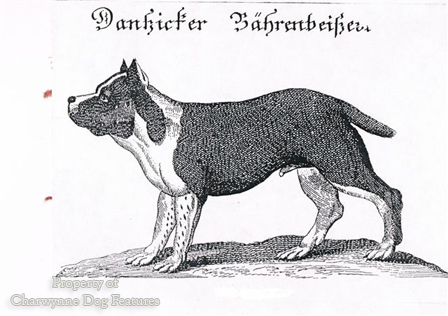
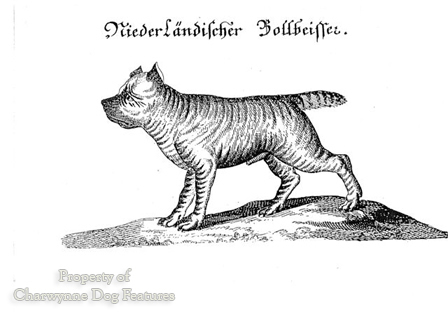
If you look at prints, engravings and paintings of hunting scenes in northern medieval continental Europe, you can soon detect strong-headed mastiff-type dogs, usually depicted at the kill of the quarry concerned: boar, stag, bison, even aurochs. Such dogs were clearly in wide use and yet few survive as recognised breeds. The boarhound, used as a hound of the chase, lives on as the Great Dane, known in Germany as the Deutsche Dogge or German Mastiff, with the noun being used to denote, not a broad-mouthed dog or killing mastiff/holding dog, but a hunting mastiff or par force hound. The boarlurcher, one type of which developed into the German bullenbeisser, is arguably represented by today's Boxer, albeit in reduced size.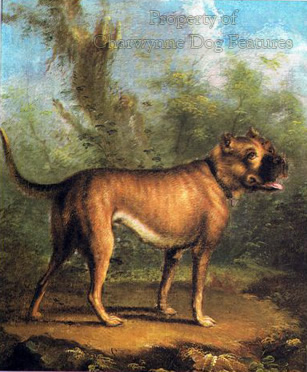
The French have their Dogue de Bordeaux, probably a legacy of two hundred years of the English presence there, for Englische Doggen or English hunting mastiffs were widely prized on mainland Europe. But where are the Dutch, Belgian, Danish and Polish holding dogs of old? We can find references to the Niederlandischer Bollbeisser, the Brabanter Bullenbijter, the Danische Dogge and the Danzigger Bahrenbeisser. The first two may well have become draught dogs, where their power and determination could be exploited; certainly some went to South Africa with the Dutch colonists to help create the breed of Boerboel. The Danish are now reviving their version as the Broholmer or Mastiff of Broholm Castle. But Eastern Europe has lost the 'holding and seizing' dogs once found there.
Breeders of Boxers should be congratulated on breeding out the awful coarseness which many 'modified brachycephalic' breeds can so easily display, especially in the head and neck and usually on into the shoulders. The Bullmastiff, purebred for three quarters of a century and with fewer ingredients than manufactured breeds like the Dobermann, the Rhodesian Ridgeback and the Black Russian Terrier, so often features this undesirable coarseness, which spoils this quite admirable breed. But the lack of substance in the contemporary breed of Boxer, together with too short a muzzle, spoils that breed too.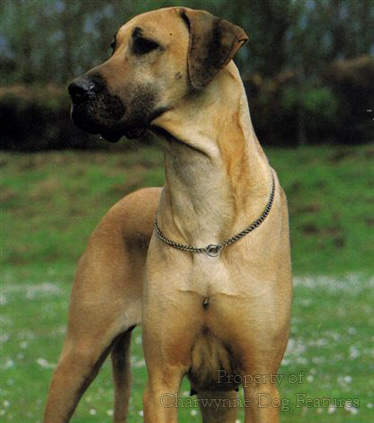
Yet the breed standard calls for: strong bone and evident, well developed muscles; chest deep...ribs well arched; hindquarters -- Very strong with muscles hard and standing out noticeably under skin. It also asks for a dog which is: distrustful of strangers, with a guarding instinct. Far too many that I see behave as adults like retarded puppies. I do not know of any organisation, even in Germany today, which uses the breed as a guard dog. When I first lived in Germany nearly forty years ago, the breed had wide employment in this role. I can't remember the last time I saw a solid brindle in Britain; every exhibit seems to feature the white socks, white brisket and white blaze of an apparently desired uniformity. Years ago a strapping solid brindle Boxer was an impressive sight.
In his excellent book 'The Boxer' of 1949, the American John P Wagner wrote: "In the other extreme, refinement, or just plain raciness predominates at the expense of substance. If the Boxer is developed in this direction he will be high, small-boned and narrow chested, lacking even sturdiness." This is how I see far too many Boxers in England today. Up until the early 1890s there was still some unwise inter-breeding between English Bulldogs and German Boxers, leading to concerns about the developing breed becoming too low-slung and cloddy. Perhaps the fear of a return to this has led to a contemporary breed which is too light, too finely timbered and under-muscled. The German ancestors of the Boxer were catch-dogs and would not have lived long if they lacked power and substance.
The French catch-dog, the Dogue de Bordeaux, boar-lurcher and hunting mastiff par excellence, hardly lacks substance. But I do see too many cloddy specimens, low-set, over-dewlapped and coarse in the neck and shoulders. This type seem to feature too an undesirable 'Chippendale' front, in which the front legs bend in at the pasterns then out again in the feet. Yet this breed has one of the best written breed standards I have ever read. Its list of faults, especially disqualifying faults, gives clear unambiguous guidance to breeders and judges and should be a model for the other mastiff breeds.
Shown at the first French dog show in Paris in 1863, the breed once had three types: the Toulouse, the Paris and the Bordeaux type, which prevailed. The breed was imported into England in the 1890s by two Bulldog fanciers, Woodiwiss and Brooke. Woodiwiss purchased a fighting dog, scarred from combat with bears as well as dogs. Not to be outdone, Brooke imported from Bordeaux itself a fawn dog, with immediate ancestors which had tackled wolf, bear and hyena, one being killed in San Francisco whilst taking on a jaguar. Brooke tried his dog at a large Russian bear which stood six feet high when up on its hind legs. The account of this contest stated that: "The dog showed great science in keeping his body as much sideways as possible, to avoid the bear's hug, and threw the bear fairly and squarely on the grass three times."

I like bears too much to approve of such a contest but the enormous strength and determination of the dog has to be of note. The Kennel Club's anti-cropping regulation dampened the enthusiasm of these early British fanciers however, with both Woodiwiss and Brooke selling their dogs to a Canadian who exported them. Now the breed is gaining favour in Britain once again, attaining KC recognition in 1997. Britain does not however have an entirely admirable record in breeding its own mastiff breeds soundly and in their correct historical mould. I do hope this breed doesn't end up as a caricature of itself, as some Bulldogs and Mastiffs sadly do.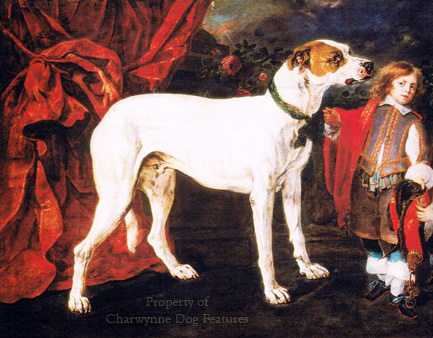
Yet to be seen in Britain is the restored Danish breed of Broholmer, rescued by Danish enthusiasts from near extinction, and now being painstakingly developed as a recognised native breed. At first glance it resembles the portrayals of the Lyme Hall mastiffs, once conserved by the Legh family in Cheshire. Plainer headed than most mastiff breeds, lacking any exaggeration or coarseness, they are genetically important and their survival is to be welcomed. Unlike the Lyme Hall dogs, whose importance has been usually exaggerated by Mastiff breed historians, this Danish dog has to my mind been surprisingly unacclaimed. Just as the Great Dane is misleadingly called a German Mastiff, so too is the Broholmer called the Mastiff of Broholm Castle; both are running mastiffs or par force hounds not holding and seizing dogs. 
These two Germanic breeds may well have come to the fore when the Celts were pushed out of east France and west Germany, for the hunting dogs of the Celts were famous and much admired by both the Greeks and the Romans. I suspect that the strong-headed par force hounds of the Celts were of the Irish Wolfhound type if not size, and live on in the French hounds like the Griffon Nivernais, the Grand Griffon-Vendeen and the Grand Fauve de Bretagne. All of these were used on stag, wolf and boar. A broad-mouthed, drop-eared, smooth-coated, modified brachycephalic holding and seizing dog does not feature on Celtic artefacts but strong-headed, longer-muzzled, usually rough-coated hounds do.
In times of moral vanity, when city dwellers can dictate what country people can and cannot do and when anyone daring to make a sport out of vermin-control is stigmatized, powerful hunting dogs are little valued. Introverted scholars can write lengthy tomes on medieval times without ever mentioning the dominating role which hunting the bigger game had then. Big strapping dogs with a distinguished hunting past, in man's service, are targetted under the scandalous Dangerous Dogs Act. Even intelligent people tend to see every contemporary event through puely twenty-first century eyes. Sportsmen need to keep their nerve; hunting mastiffs may yet be needed in our unpredictable world. Let's keep the gene-pools going.